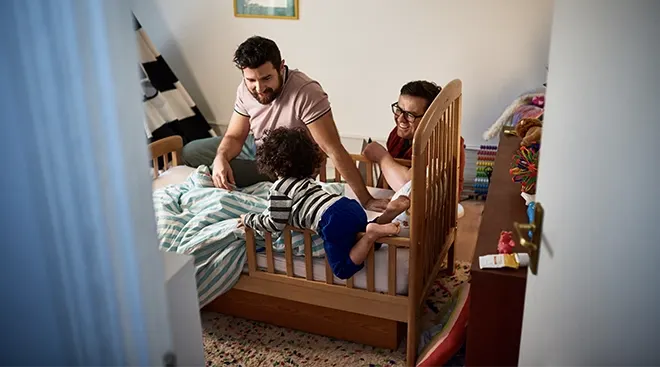How to Sleep Train a Toddler (and Should You?!)
You’re likely here because your toddler isn’t a huge fan of sleeping, whether they’re waking up in the middle of the night (possibly for a two-hour party), stalling (and stalling) bedtime or waking at 4 a.m.—for the day. And you’re exhausted. Aren’t they supposed to be sleeping through the night by now? Believe us, we’ve been there and we get it. While it’s developmentally normal for a toddler to crave connection before bedtime, getting a solid block of sleep is also really important for your little one’s health (and your sanity). It can be a tough call to make, but at some point you may find yourself looking into toddler sleep training. We asked the experts for tips, methods—and alternatives for how to get a toddler to sleep if traditional sleep training isn’t your thing.
“[Toddler] sleep training is a way of intentionally teaching your toddler to independently fall asleep and sleep through the night in their own sleeping space,” says Cara Dumaplin, RN, BSN, pediatric sleep consultant and founder of Taking Cara Babies. Toddler sleep training generally involves making changes to a toddler’s sleep habits, routines and/or schedule to address sleep challenges, adds Rachel Mitchell, pediatric sleep consultant and founder of My Sweet Sleeper.
If you’re interested in how to sleep train a toddler, the experts break down toddler sleep training methods:
Chair method
In this method, you sit in a chair next to your child’s crib or bed and gradually move the chair farther away each night until you’re out of the room, says Dumaplin.
Pick up, put down
For this method, you would pick up your child anytime they’re crying to provide reassurance and put them back in their crib or bed as soon as they’re calm, says Dumaplin. Mitchell also calls this method “fading” and says it doesn’t need to involve picking up and putting down: “If your child is older, this would look like you sitting next to their bed until they fall asleep and then working your way out of the room once they have fallen asleep,” she says. “Then, over time you can gradually work your way out of the child’s room while they’re awake to give them a bit more independence.”
Graduated extinction
Popularized as the Ferber method, graduated extinction involves checking in on your little one to provide reassurance at set intervals, says Dumaplin.
Cry it out
This method involves “simply putting a toddler in the crib or in their room, closing the door and coming back to get them in the morning,” says Dumaplin. That said, she adds, “With toddlers, typically a more gentle, gradual approach is more effective.”
Dumaplin adds that it’s more important to have a big-picture plan that accounts for who your child is as a person than a method. To improve toddler sleep, she says it’s important to take into account:
- Your toddler’s sleep needs for both naps and nights
- Their emotional, physical and mental well-being
- Your parenting and behavioral strategies
Dumaplin says that toddler sleep training—or, more specifically, having a well-rested toddler—has quite a few benefits. “Toddlers who are well-rested have better outcomes in growth and development, physical and mental health, social development, emotional regulation, adaptability and more,” she says. “Better sleep for toddlers also means better sleep for parents. And a well-rested parent is healthier, happier and more emotionally available to their little ones. Good sleep for toddlers helps little ones to flourish and the whole family to thrive.” She points to a study that explains how “restorative and quality sleep are essential for proper growth and development,” research that finds children who sleep well are better able to regulate their emotions and findings that sleep plays an important role in immune function. Finally, she notes that research shows poor sleep for parents can “increase conflict, negatively impact mood and decrease empathy.”
When it comes to sleep training a toddler, there are a few challenges, according to the experts:
They’re, well, a toddler
“By the time they reach toddlerhood, children begin to understand that they have a voice and can make choices that influence others and the world around them,” says Dumaplin. “They’re more independent and have a mind of their own. This is an amazing development, but it also presents unique challenges for sleep training.” This means, she adds, “you have to help them want to stay in bed and sleep.”
It may take more time
As opposed to sleep training a baby, toddler sleep training might take more time since your current habits and routines are likely well-established, says Mitchell. On average, teaching a toddler new sleep habits could take three to six weeks and sometimes longer, she says.
There’s crying
While she doesn’t personally follow a cry-it-out approach, Mitchell says some tears are to be expected as your little one deals with changes they may not like. “The important thing is not to stop the crying from happening, but to comfort your child when needed and ensure you’re lovingly and gently holding the boundary,” she says.
Separation is hard
“Bedtime represents a huge separation to a young child, and separation is perhaps one of the most stressful events that they can go through,” says Rachael Shepard-Ohta, MEd, a San Francisco-based baby and toddler sleep consultant and owner of Hey, Sleepy Baby, who says she doesn’t support toddler sleep training practices. Separation sets off the “alarm system” in toddlers’ brains, which is why they may have tantrums and stall bedtime. As a mom of three, Shepard-Ohta says she understands how these behaviors can be “incredibly draining” for busy parents, so she offers alternative solutions for sleep issues (more on these below).
How long it takes to sleep train a toddler varies a lot between families because everyone starts from different places, says Dumaplin. “Some families start sleep training with a toddler who has never slept outside of their parents’ bed, while for others, their toddler was an independent sleeper who ran into hiccups after transitioning to the toddler bed,” she says.
Mitchell says that, in her experience, toddler sleep training takes around three to six weeks, and sometimes longer. “Generally though, I see a lot of improvement in this timeframe,” she notes.
Here are a few toddler sleep training tips from real parents:
- “I hired a sleep trainer for my 3-year-old this week—it was taking 2.5 hours to get him to sleep before I hired her. He’d wake up at 2:30 a.m. and be up until 5. I also hired one for my oldest a few years ago and it worked like a charm. (They’re not physically there, but they give virtual support by text before and during bedtime and in the morning.) It’s hard in the beginning because, like every toddler, they want to push boundaries as much as possible, but consistency is key. Working with a professional is humbling: Everything they’re saying sounds so simple. But in reality, when it’s bedtime, I’m a single mom juggling three small kids and it’s hard. Putting in the effort for a couple of weeks is so worth it so I can get time back in my evening.” — Megan B., global workplace director at The Knot Worldwide and mom of three
- “We’re using a book to help us out with our 5-year-old and 6-month-old: The Happy Sleeper helps us work on a routine.” — Kayla B., product developer at The Knot Worldwide and mom of two
- “We do our bedtime routine around 7, start with a bath, brush teeth, read stories, our 5-year-old son listens to a podcast to wind down called Ahway Island, and then we all give him hugs and kisses and have him listen to calming instrumental music. When he was 2, we made a bedtime and morning routine board to help him know what to expect during those crucial times in the day.” — Kayla B., product developer at The Knot Worldwide and mom of two
It’s possible that the typical baby and toddler sleep training methods haven’t worked for your family—or you’ve simply decided they’re not right for you. Luckily, there are plenty of other ways to optimize your toddler’s sleep. Here are a few ideas Shepard-Ohta recommends:
Do an “audit” of their sleep schedule
“Most children between the ages of 12 months and 2, need between 11 and 14 hours per 24-hour cycle. By age 3, it drops to just 10 to 13 hours per day,” says Shepard-Ohta. “What this means is that for many young children, bedtime is a battle simply because they aren’t tired enough. Either the nap is too late, bedtime is too early or both! … Having a realistic sense of how much sleep to expect from your child and embracing meeting them where they are for right now can be incredibly freeing.”
Fill their “sensory tank”
Children crave sensory input, and not getting enough during the day can make it hard for their nervous systems to go into “rest and digest” mode. This means everything from running to crawling through tunnels! Closer to bedtime, Shepard-Ohta recommends more “heavy work” activities to help kids wind down: Things like pushing or pulling heavy boxes or bags—and big bear hugs.
Make sure you have a routine
A consistent bedtime routine has been proven to have positive effects on kids’ sleep. “Kids thrive when they know what to expect and what’s coming next,” says Shepard-Ohta. “A simple bedtime routine that’s the same each night helps to ground your child because they know it’ll be the same every night. This can prevent lots of battles, negotiations and opposition.”
Fill their “connection cup”
Again, bedtime is a big separation for kids, she says, and it’s a time they simply want to connect with us. “I like to tell my kids stories or listen to a mindfulness app or special playlist with them before bed,” Shepard-Ohta says. “My husband gives them each a back scratch or lays with them while they fall asleep.”
Frequently Asked Questions
What’s the best age for sleep training?
There’s no “perfect” age for sleep training, says Dumaplin. “You can start to work on healthy sleep habits from birth, but for formal sleep training, we need to wait until babies are developmentally ready,” she says. “That can be as early as 5 months, and sleep training can be appropriate from 5 months until your little one reaches 5 years. The best age for sleep training is when parents decide it’s right for their family.”
If you decide to sleep train your toddler, it’s a good idea to speak to your pediatrician before you start. And whether or not you decide that sleep training is right for you, it’s also a good idea to evaluate your toddler’s sleep schedule, establish a bedtime routine and make sure they get plenty of hugs before bed.
Please note: The Bump and the materials and information it contains are not intended to, and do not constitute, medical or other health advice or diagnosis and should not be used as such. You should always consult with a qualified physician or health professional about your specific circumstances.
Plus, more from The Bump:
Cara Dumaplin, RN, BSN, is a mom of four, neonatal nurse, wife of a pediatrician and pediatric sleep expert. She started Taking Cara Babies in 2013 to give parents a voice they can trust, one who uses the expertise of a nurse and the heart of a mama. Since then, she has helped nearly 3 million families through social media and her online classes. Cara's passion is handing parents the tools and confidence they need to help their little ones sleep so the whole family can thrive.
Rachel Mitchell is a Boston-based certified maternity and pediatric sleep consultant, former night nanny and mom to seven. She’s the founder of My Sweet Sleeper, a team of maternity and pediatric sleep specialists that help growing families get some much needed shut-eye, as well as the founder of Sweet Sleep Academy, a pediatric sleep consultant certification program.
Rachael Shepard-Ohta, MEd, is a San Francisco-based baby and toddler sleep consultant and owner of Hey, Sleepy Baby. She is also an elementary education specialist.
Journal of Pediatric Health Care, Sleep in Infants and Young Children, March-April 2004
BMC Public Health, Systematic Review of the Relationships Between Sleep Duration and Health Indicators in the Early Years (0–4 Years), November 2017
Pflügers Archiv - European Journal of Physiology, Sleep and Immune Function, November 2011
Psychoneuroendocrinology, Shortened Sleep Fuels Inflammatory Responses to Marital Conflict: Emotion Regulation Matters, May 2017
Learn how we ensure the accuracy of our content through our editorial and medical review process.
Navigate forward to interact with the calendar and select a date. Press the question mark key to get the keyboard shortcuts for changing dates.




















































